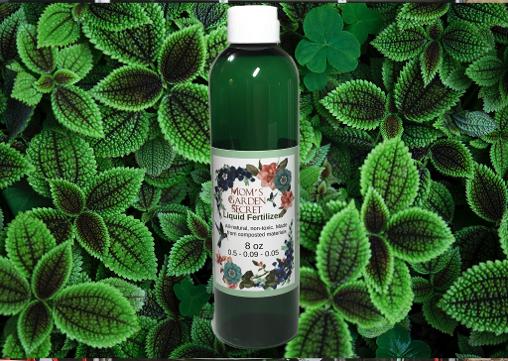ALL ABOUT FERTILIZERS
They were watered equally and allowed to grow.
The plant on the right was given Mom's Garden Secret fertilizer while the one on the left was not.
You can see the difference in growth. The left plant has yellowed leaves as well as being much smaller indicating it is malnourished.
What are fertilizers anyways? There seems to be so many kinds to add to the garden or house plant, so how does one choose? Let's take a look at some basic facts about fertilizer.
What is a fertilizer?
Fertilizers are concentrated nutrients that you add to the soil to help the plants grow well.
After all, you need nutrients from the food you eat in order to grow and be healthy.
So do plants.
And just so you know, we get our nutrients from the plants we eat. If your plant food does not get its nutrients from the soil, you won’t get those nutrients from those plants either.
As plants grow, they use up the nutrients in the soil and they need to be replaced. So we add fertilizer to the garden soil to ensure that our plants grow well and are healthy for our own food intake.
There are two basic kinds of fertilizers: organic and inorganic. Let’s take a look at what they each are.
Organic fertilizer
Organic fertilizer comes from naturally occurring resources such as plants, animal byproducts and mineral rock.
Examples of this are compost (decomposed plant material, egg shells, coffee grounds and even shredded paper), manure (can include bat guano, bird guano, and manure from cattle, horses and sheep), marine byproducts (sea weed and fish emulsion), meals (bone meal, blood meal, and cottonseed meal), minerals from underground ancient sea beds(dug out from mines) and mulch (which has been created using shredded leaves, grass clippings, and old hay).
Minerals do not come from live sources but they are included here because they occur naturally and are not man made.
Inorganic fertilizer
These are made by man synthetically and usually from petroleum.
These are the usual fertilizers you find in stores that contain the three basic ingredients of nitrogen, phosphorus and potassium. They are symbolized by the letters N, P, and K and numbers respectively and you will find them on the packages of fertilizer in various proportions.
The numbers that are there show the proportions. For example, 1-1-1 shows that there are even proportions of N, P and K while 2-1-1 shows more nitrogen than the other two.
Nitrogen is good for healthy foliage.
Potassium encourages stem growth and helps the plant fight off disease.
Phosphorus helps with root development, flower and seed formation. It also helps fight off disease.
So the different fertilizers specialize in what you intend to achieve with your plants – leaves, roots or flowers and fruit.
For example, a good lawn fertilizer will have more nitrogen than the other two ingredients, while your flower bed does better with a higher amount of potassium. Both organic and inorganic fertilizers have advantages and disadvantages.
But we will only cover the critical difference here. Synthetic fertilizers contain only the three minerals indicated above, while organic fertilizers contain the entire spectrum of minerals. The human body does not assimilate synthetic minerals as well as organic ones.
That being said, let's look at Mom's Garden Secret Liquid Fertilizer.
Mom’s Garden Secret Liquid Fertilizer is organic, made from bat guano, worm castings and blood-meal, bone meal, kelp and many more composted organic matter.
It contains more than the three nutrients that the synthetic fertilizers embrace and it is all natural. This means that the plants use what they need and the rest stays in the soil until needed again.
There is no fertilizer burn in using too much and the nutrients are easily accessible to the plants.
One tablespoon in a gallon of water makes this product economical.
You can purchase an 8-ounce bottle for your garden HERE.
